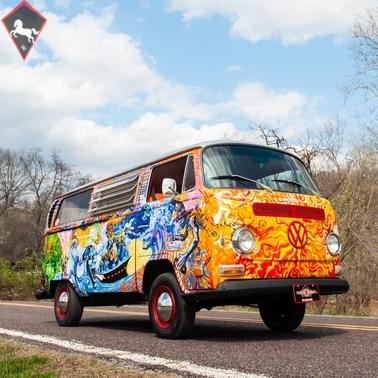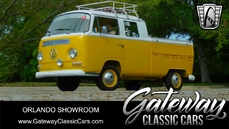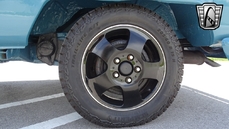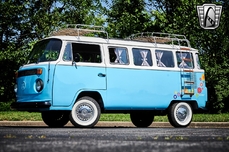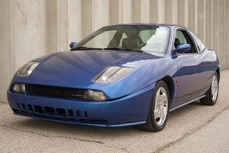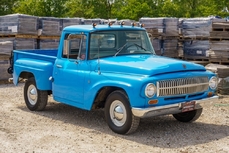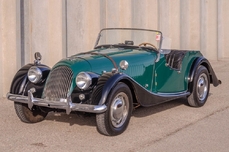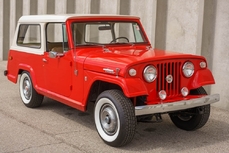Volkswagen Typ 2 Bay window 1.6L Four-cylinder 1971
General description :
1971 Volkswagen Bus
Early work by Jason McCarty, an Iowa artist who died in the “Ghost Ship” warehouse fire in Oakland, CA in December 2016
Every vertical exterior surface has been transformed into a work of art; roof is silver
Autographed by the artist
Custom interior
1.6L flat four-cylinder engine
Four-speed manual transmission
12-volt electrical system
Power brakes
Documentation includes photos of Jason creating his art, photos of the completed work, high school photos of the artist and Iowa newspaper articles about the fire
On December 16, 2016, a fire started in a warehouse located off of Fruitvale Avenue in Oakland, California. Now known as the “Ghost Ship” Fire, unfortunately 36 people died in the blaze. Artist Jason McCarty was one of them. This VW Bus represents one of his early works completed before he moved to California and it is autographed by McCarty. It was originally a blank red canvas.
An Iowa native, he created art from a very early age. McCarty, 36, dabbled in a variety of media – illustrations, design, photography, painting and music. He moved to California in approximately 2006, when he began his master’s coursework at the San Francisco Art Institute.
The van’s nose is a mélange of warm hues in sun-like pattern. Moving around to the driver’s side, the yellows and oranges become part of a fire-breathing dragon’s exhalations. Past the driver’s door the dragon’s body undulates and a possible underwater scene hovers above the dragon’s back. Over the left rear wheel is a hippie panorama, complete with rainbow, peace signs and other traditional symbols. A large green frog occupies the driver’s D-pillar. Arcing across the rear is an emotive set of sun and moon phases, complete with a long red-and-white stocking cap on the moon. The passenger D-pillar bears a character who would look at home in J.R.R. Tolkien’s “Lord of the Rings” trilogy. Down the passenger side is a very mystical and psychedelic scene, with mushrooms, a Willy Wonka-like character and other images of which Tom Petty would have enjoyed.
The paint and trim are in overall very good order, as are its glass panels and lights. The van’s bodywork is straight while its cargo area is in very good order, however the heater boxes for the engine are missing. The black bumpers are in very good order. The van rolls on Douglas radials, size 185/75R14 at all four corners. The tires are in decent condition and each one surrounds a steel wheel topped with a vented factory wheel cover.
Inside, the newer shag carpet and upholstery are eye-catching. The seats are in excellent order while the matching shag carpet is in very good condition. The headliner is satisfactory, as is the two-spoke steering wheel. The black instrument panel and inner door panels are in very good condition. The fuel gauge is inoperable. Rounding out the interior is a Sony AM/FM stereo. The side entry door has been ingeniously transformed from a slider to a hinged “suicide” door, making it very unique.
In late 1967, the second generation of the Volkswagen Type 2 (T2) was introduced. It was built in Germany until 1979. Models before 1971 are often called the T2a (or “Early Bay.”)
This second-generation Type 2 lost its distinctive split front windshield and was slightly larger and considerably heavier than its predecessor. Its common nicknames are Bread loaf and Bay-window, or Loaf and Bay for short. At 1.6 L, the new engine with dual intake ports on each cylinder head was also slightly larger. The battery and electrical system was upgraded to 12 volts, making it incompatible with electric accessories from the previous generation. The new model also did away with the swing axle rear suspension and transfer boxes previously used to raise ride height. Instead, half-shaft axles fitted with constant velocity joints raised ride height without the wild changes in camber of the Beetle-based swing axle suspension. The updated Bus transaxle is usually sought after by off-road racers using air-cooled Volkswagen components.
The first models featured rounded bumpers incorporating a step for use when the door was open (replaced by indented bumpers without steps on later models), front doors that opened to 90° from the body, no lip on the front guards, unique engine hatches and crescent air intakes in the D-pillars. An important change came with the introduction of front disc brakes and new roadwheels with brake ventilation holes and flatter hubcaps. Up until 1972, front indicators are set low on the nose rather than high on either side of the fresh air grille – giving rise to their being nicknamed “Low Lights.”
Competition to this Volkswagen in 1971 included Chevrolet’s G-Series Van, Dodge’s B-100, Ford’s Econoline, GMC’s VanDura.
Documentation includes photos of Jason creating his art, photos of the completed work, high school photos of the artist and Iowa newspaper articles about the fire.
This is more than a typical Volkswagen Bus, this is an artist’s rolling mural from a segment of his life. If you are interested in this unique VW, please stop by MotoeXotica Classic Cars as soon as possible.
PLEASE CLICK HERE TO VIEW OUR YOU TUBE VIDEO!
OR COPY AND PASTE THE LINK BELOW INTO YOUR WEB BROWSER:
https://youtu.be/0CE2y5r6hik
This car is currently located at our facility in St. Louis, Missouri. Current mileage on the odometer shows 62,881 miles. It is sold as is, where is, on a clean and clear, mileage exempt title. GET OUT AND DRIVE!!!
VIN: 2312043507
https://www.motoexotica.com/inventory/listing/1971-volkswagen-bus/
1971 Volkswagen Typ 2 Bay window 1.6L Four-cylinder is listed sold on ClassicDigest in Fenton (St. Louis) by for $26900.
Car Facts
Car type : Car Make : Volkswagen Model : Typ 2 Bay window Model Version : 1.6L Four-cylinder Engine size : 1.6 Model Year : 1971 Sub type : Van Location : Fenton (St. Louis)
Sold
Seller Information
Sold
People who viewed this Volkswagen Typ 2 Bay window also viewed similar Volkswagen listed at ClassicDigest
Other cars listed for sale by this dealer
About Volkswagen
The Volkswagen story is indeed an intriguing tale of innovation, resilience, and post-war revival, marked by various models that have become iconic in automotive history.The People's Car (Volkswagen): Initially envisioned by Adolf Hitler in the 1930s as a "people's car" or "Volkswagen" in German, the idea was to create an affordable and practical vehicle for the German people. This concept led to the development of the Volkswagen Beetle (or the Type 1), designed by Ferdinand Porsche.
Post-War Challenges: After World War II, Volkswagen faced significant challenges. The factory was heavily damaged, and the brand's association with the Nazi regime led to a lack of interest in the car in some regions.
British Intervention - The British Army & Ivan Hirst: The British Army took control of the factory in the immediate post-war period. Major Ivan Hirst, a British Army officer, played a crucial role in reviving Volkswagen. He recognized the potential of the Beetle and advocated for its production, convincing the British military to order several thousand cars. This decision helped jumpstart the brand's revival.
Export Success and the Beetle's Global Appeal: The Beetle gained popularity not only in Germany but also globally, becoming an icon of affordable motoring. Its simple, reliable design and unique appearance made it a favorite among consumers worldwide.
Model Evolution: Over the years, Volkswagen introduced various models alongside the Beetle, each contributing to the brand's growth:
Type 2 (VW Bus or Transporter): Introduced in the 1950s, it became an iconic symbol of the hippie movement in the 1960s, loved for its spaciousness and versatility.
Golf (Rabbit in the U.S.): Launched in the mid-1970s, the Golf (or Rabbit in the U.S.) marked a shift towards front-wheel-drive, modern design, and hatchback practicality, becoming a cornerstone of the brand's success.
Passat, Jetta, and Other Models: Volkswagen expanded its lineup with models like the Passat and Jetta, catering to different market segments.
Challenges and Innovations: Despite success, Volkswagen faced challenges, including quality issues in the 1970s. However, the brand continued to innovate and develop new models and technologies.
Rise of the GTI and Global Expansion: The 1980s saw the rise of the iconic Golf GTI, a high-performance version that sparked the hot hatch trend. Volkswagen also expanded its global presence during this period.
The British intervention in reviving Volkswagen after World War II played a pivotal role in the brand's resurgence. While there might have been some tensions or competition among automotive companies in the 1950s and 1960s due to Volkswagen's post-war success, the brand's ability to produce innovative and popular models solidified its place in automotive history.
